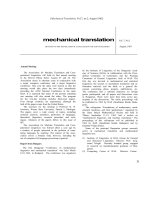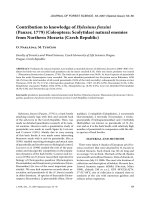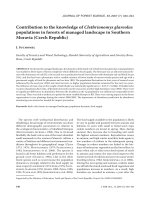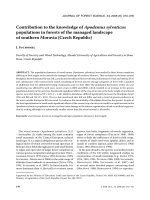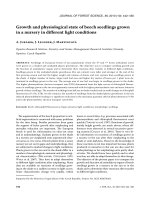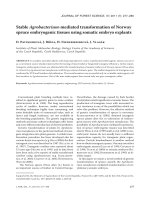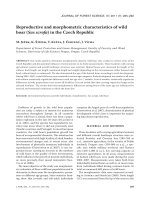Báo cáo lâm nghiệp: "Contribution to the knowledge of Clethrionomys glareolus populations in forests of managed landscape in Southern Moravia (Czech Republic)" pot
Bạn đang xem bản rút gọn của tài liệu. Xem và tải ngay bản đầy đủ của tài liệu tại đây (208.97 KB, 5 trang )
340 J. FOR. SCI., 53, 2007 (7): 340–344
JOURNAL OF FOREST SCIENCE, 53, 2007 (7): 340–344
The species with widespread distribution and
inhabiting a broad range of environments can show
different demographic parameters in relation to
the ecological characteristics of inhabited biotopes
(M, G 1985). Due to its broad
flexibility the bank vole as one of the most abundant
small mammals in the western Palearctic utilizes a
variety of habitats and different environmental con-
ditions throughout its geographical range (Z
1973, 1976; M 1979; P
1983; J et al. 2004). e species is
found in all forest habitats with preferences for the
ground cover (G 1985). Like in the other
forest species such as wood mouse the population
dynamics is strongly related to the food supply (as
mast crops) (F 1973; Z 1976; F-
, G 1978; J 1982; Z 1985,
1991; P et al. 1993; J et al. 2004).
e food supply available to the population is likely
to vary in quality and quantity between seasons and
habitats. In years with small or failed seed crops
rodent numbers are lowest in spring. en, during
summer they increase due to breeding and reach
the highest autumn numbers. Reproduction ceases
in autumn, and high winter mortality leads again to
low numbers of rodents in the subsequent spring.
Changes in rodent numbers are linked to the bio-
mass of herbaceous vegetation on the forest floor. In
years when oak or other trees shed masses of seeds
in autumn and winter, the extra food improves the
winter survival of rodents and can even cause winter
breeding (Z 1962; J et al. 2004).
During the next spring and summer, rodents make
use of both the stored seeds and fresh vegetation and
populations increase in numbers. As a result, high
densities are recorded in autumn, a year after the
Supported by the Ministry of Education, Youth and Sports of the Czech Republic, Project No. MSM 6215648902.
Contribution to the knowledge of Clethrionomys glareolus
populations in forests of managed landscape in Southern
Moravia (Czech Republic)
J. S
Faculty of Forestry and Wood Technology, Mendel University of Agriculture and Forestry Brno,
Brno, Czech Republic
ABSTRACT: In intensively managed landscape, the dynamics of the bank vole (Clethrionomys glareolus, Cg) populations
was studied in three types of forest complexes which differed in food supply. e first type was an old semi-natural fo-
rest with dominance of oak (HL), the second was a production broad-leaved forest with dominant oak and black locust
(HA), and the third was a pheasantry with a variable mixture of forest stands of various woody species and age with a
permanent supply of food for pheasants and roe deer (RB). e population fluctuations in four years of research were
influenced by the seed year (2003, oak mast harvest), so higher population densities remained for the next two years.
e influence of mast crop on the weight of individuals was statistically significant (α = 0.05, P = 0.0484). Probable niche
vacation (Apodemus flavicollis, Af densities lowered) was the reason for another high abundance year (2005). ere were
no significant differences in abundance between the localities as the Cg population was influenced comparably by the
seed crop. ere was only a tendency to prefer the most variable biotope in RB. ere was a strong impact on the forest
regeneration in tree plantings during the winter 2004/2005. e importance of abundance prediction by abundance
monitoring was stressed as needed for impact prevention.
Keywords: bank vole; forests in managed landscape; population dynamic; food supply
J. FOR. SCI., 53, 2007 (7): 340–344 341
seed fall. In the present study we compare some de-
mographic parameters (abundance, sex ratio, breed-
ing activity and body mass) in three populations of
Cg inhabiting different forest habitats which widely
differ in food supply. Special attention was concen-
trated on the RB locality with a permanent supply
of food to pheasants and roe deer. e development
of populations under the influence of seed years was
also described.
MATERIAL AND METHODS
e material was obtained from three study sites
in the years 2002 and 2005. ese were larger for-
est complexes, isolated in the intensively managed
landscape of South Moravia (Czech Republic). e
sites are characterized by different intensity of the
exploitation by people, and by defined groups of
forest types (R et al. 1986).
e location Horní les (HL) (120 ha) is a seminatu-
ral forest stand, characterized by the group of forest
types Ulmeto-Fraxinetum carpineum. It is situated
near Lednice in Moravia. e dominant species are
common ash (Fraxinus excelsior), English oak (Quer-
cus robur), black poplar (Populus nigra), broadleaved
lime-tree (Tilia platyphyllos), and common maple
(Acer campestre).
The location Hájek (HA) (60 ha) is a typical
production forest, characterized by the group of
forest types Carpineto-Quercetum acerosum. It is
situated near Vranovice. e dominant woody spe-
cies are English oak (Quercus robur), durmast oak
(Q. petraea), and black locust (Robinia pseudoaca-
cia). e shrub stratum was little developed and
mosaic-like. It consisted of shrubs of Crategus
oxyacantha and Eonymus europaea beside scattered
bushes of Carpinus betulus.
e location Rumunská (RB) (280 ha), situated
near the town of Židlochovice, is used as an intensive
pheasantry. With regard to microhabitats, the loca-
tion Rumunská is the most variable area of the three
locations. It includes a number of miscellaneous
woody species of various age categories as well as
small open areas, such as meadows, small fields, and
wetlands. e most prevalent woody species in this
location are English oak (Quercus robur), durmast
oak (Q. petraea), Scotch pine (Pinus silvestris), com-
mon spruce (Picea abies), and black poplar (Populus
nigra). e following groups of forest types were
identified there: Ulmeto-Fraxinetum carpineum, Sa-
liceto-Alnetum and Carpineto-Quercetum acerosum.
e annual mean air temperature in the studied
area was 9.5°C; the total annual precipitation was
545 mm.
In each locality under study the immediate supply
of mast diet was evaluated on ten plots 0.5 m
2
in size,
and the mean amount of mast was determined.
In all trial plots, the methodology of traditional
line trapping was applied (P 1975). Snap
traps were used and baited with a wick fried in pork
fat or spread with peanut butter. e animals were
trapped at even intervals five times a year in the years
2000–2005. Each catch took three trap-nights. e
trapped individuals were dissected in a laboratory.
ey were classified according to the species, body
size, sex, and sex condition. From this material the
population of Cg was evaluated.
e relative abundance of Cg rA was expressed
as the number of individuals trapped per number
of trap-nights. Data on the bank vole impact were
collected by Forestry control. e changes in the
localities and yearly abundances of the Cg population
were compared by Wilcoxon’s matched pair test. e
differences between body masses were compared by
HDS test (ANOVA). All statistical tests were com-
puted using the program Statistica for Windows 6.1
(Statsoft 2000).
RESULTS
During 20 trapping periods (20,150 trap nights)
2,112 individuals of small mammals were recorded.
As to the individual species Apodemus flavicollis,
A. sylvaticus, Clethrionomys glareolus, A. microps,
Microtus arvalis, Microtus subterraneus, Mus mus-
culus, Sorex araneus, Crocidura leucodon and C.
suaveolens were trapped. Of these 442 (20.9%) were
Cg individuals.
Population fluctuations of Cg during the four years
of study varied and a strong influence was exerted by
the seed year (2003, oak mast harvest; Fig. 1). In the
HL forest the amount of food supply in the form of
oak mast was the highest (208 g/m
2
) in contrast to
RB (69 g/m
2
), but in RB additional food was given to
pheasants and roe deer during the whole year. ere
were no significant differences in abundance between
the localities as the Cg population was comparably in-
fluenced by the seed crop. ere was only a tendency
to prefer the most variable biotope in RB (rA = 2.58).
Lower abundance was found in HL (2.21) and the
lowest in HA (1.64), which was influenced by food
supply and also probably by competition with Af.
Differences in the body weight of Cg (if the years
2003 and 2004 were compared – influenced by the
seed crop) were statistically significant (α = 0.05;
P = 0.0484).
Autumn prolonged breeding (progradation phase)
in the year influenced by mast crop (2004), and prob-
342 J. FOR. SCI., 53, 2007 (7): 340–344
able niche vacation (Af densities lowered) was the
reason for another high abundance year (gradation
phase 2005) (Fig. 1).
Comparing the sexual activity in the particular
localities it was the highest in HL (57% of active fe-
males) and the lowest in RB (48%). e sex ratio was
almost balanced in RB and HL but slightly shifted to
the male dominance (59%) in HA.
Body mass and length were compared and the
tendency to be highest was in RB (weight: max. 38 g,
min. 9 g, mean 21.36 g; length 90.7 mm) and lowest in
HA (weight: max. 35 g, min. 12 g, mean 20.2 g; length
90.4 mm) the differences not being significant.
A strong impact on forest regeneration was found
in southern Moravian forests as exerted by the bank
vole gnawing the stems of young trees. In controlled
forests 40% of young oak plantings were damaged to
some extent after winter 2004–2005 but no impact
was observed in winter 2005–2006.
The only effective prevention against damage
seems to be the reliable prediction of population
densities by pest species monitoring and early plan-
tation protection.
DISCUSSION
During the study of small mammal populations in
three large forest complexes in southern Moravia Cg
was one of the most dominant species. e lowland
forest was characterized by the highest biomass of
the herb stratum which is the most suitable food sup-
ply for this species (G 1985). Quite different
is RB with the mosaic of forests of various age catego-
ries as well as small open areas. is was the locality
with the highest abundance after the seed year. We
presume that the variety of biotopes supplied more
space and lower competition for other species than
the most dominant Af (S, H
2006). HA is a typical production forest with differ-
ent tree species and mostly grasses in the herb stra-
tum. e preference of dicotyledonous herb species
can influence its abundance there (H 1971)
in the time of its progradation phase.
Populations of small mammal species were studied
in various types of forests such as lowland ones of
Moravia and Slovakia (e.g. Z 1976; D,
Š 1983; M 1985; Z 1985, 1991;
K 1999) and also in the other types of low
altitude forests (e.g. Z 1973). In all of them
Cg is one of the dominant species. In our study we
concentrated on the study of the population of this
species as also some other authors did (A,
G 1985; M 1991).
As to the dynamics of abundance during the 3 years
of study the years 2002 and 2004 seem to be similar.
As the harvest of seeds in forests varied in the partic-
ular years, it was observed that seed crops in the year
2001 and 2003 were medium sized. In the year 2001
there was a good harvest of hornbeam and lime seeds
and this also positively influenced the abundance and
litter size of Cg populations in 2002, especially in HA
as hornbeam and lime are highly represented there.
In 2003 and 2004 abundance and litter size were
highest in RB where food was supplied to pheasants
and deer. In 2003 there was a good crop of oak mast.
e abundance of Cg increased in all localities dur-
ing the next year 2004. According to W (1969),
F (1973), Z (1976), F
and G (1978), J (1982), Z (1985),
P et al. (1993), J et al. (2004)
and some others, large crops of tree seeds in forests
positively influence the dynamics of seed eating small
mammals in a year after the “seed year”.
In RB the population of Cg was permanently sup-
plemented by food for pheasants and deer. Under
this influence it reached the higher winter popula-
tion abundance than in the other two forests. It also
showed higher litter sizes in spring and summer.
0
2
4
6
8
10
II/III
2002
VIII/IX IV/V X/XI VI/VII II/III
2005
VIII/IX
rA
RB HA HL
rA
II/III
IV/V
VI/VII
VIII/IX
X/XI
II/III
IV/V
VI/VII
VIII/IX
X/XI
II/III
IV/V
VI/VII
VIII/IX
X/XI
II/III
IV/V
VI/VII
VIII/IX
X/XI
2002 2003 2004 2005
Fig. 1. Four-year monitoring of the rela-
tive abundance (rA) of Clethrionomys
glareolus in three forest complexes under
various environmental conditions in rural
landscape
J. FOR. SCI., 53, 2007 (7): 340–344 343
However, populations in all forests declined during
the late summer and autumn. According to W
(1969, 1970) and F (1972, 1985) food
quality appears to influence the amplitude of the
fluctuation in numbers but not the decline. It is so
that both food and behaviour are limiting numbers at
the same time. An experiment on Townsend voles in
Canada indicated that supplementary food sets the
ultimate limit to population growth but the social
organization will provide a proximate limitation,
and also that this has evolved to maximize individual
fitness (e.g. T 1983).
Our data are comparable with the findings of
K (1999) with the mean litter size being about
5 in lowland forests. Prolongation of breeding season
in a seed year was observed by Z (1976). Repro-
duction was prolonged into the beginning of Novem-
ber in our study only in one case in RB locality.
e sex ratio was balanced in our case in HL and
RB. It is characteristic feature of stable population liv-
ing in optimal habitats (A, G 1985). In HL
it was slightly shifted to the dominance of males.
e number of sexually active females indicates
the quality of the habitat (Z 1976; M-
, R-J 1989; M
1991). According to the dominance of this species
the most suitable forest type was HL (26.8%). But
no large differences were found between the locali-
ties. e highest number of females with embryos
and placental scars was found in RB, probably due
to better overwintering as indicated by higher abun-
dances during winter. e higher mean litter size
in a two-year period also confirms the influence of
supplementary food (A 1975; C,
B 1978; F 1972, 1985, 1987).
Body weight also provides information about the
habitat quality (S, H 2006).
In our case the animals of both sexes were not sig-
nificantly heavier in any of the localities. But higher
mean body weight and maximal body weight were
found in RB. is can also be influenced by the pres-
ence of supplemental food at this locality.
All the year round a high concentration of birds of
prey was observed in RB locality. eir influence on
the population of small mammal species is a question
to be answered. According to F (1987)
predators may exert a strong pressure on a decrease in
mammalian populations but, equally, they may have
a low effect on their numbers. It is a difficult factor
to consider in relation to the mammalian population
regulation without taking into account its interactions
with the behaviour and abundance of the prey popu-
lation. As the Cg is mostly active in night, predation
would be possible only by the owl species.
R ef er ence s
ALIBHAI S.K., GIPPS J.H.W.
, 1985. e population dynam-
ics of bank voles. Symposia of the Zoological Society of
London, 55: 277–313.
ANDRZEJEWSKI R.,
1975. Supplementary food and the
winter dynamics of bank vole populations. Acta erio-
logica, 20: 23–40.
COLE F.R., BATZLI G.O.,
1978. Influence of supplemental
feeding on a vole population. Journal of Mammalogy, 59:
553–566.
DUDICH A., ŠTOLLMAN A.,
1983. Micro-mammal com-
munities in the tree species formation of the East Slovakian
Lowlands. Ekológia (ČSSR), 2: 353–373.
FLOWERDEW J.R.,
1972. e effect of supplementary food
on a population of wood mice (Apodemus sylvaticus). Jour-
nal of Animal Ecology, 41: 553–556.
FLOWERDEW J.R.,
1973. e effect of natural and artificial
changes in food supply on breeding in the woodland mice
and voles. Journal of Reproduction Fertility (Supplemen-
tum), 19: 259–269.
FLOWERDEW J.R., 1985.
e population dynamics of wood
mice and yellow-necked mice. Symposia of the Zoological
Society of London, 55: 315–338.
FLOWERDEW J.R.,
1987. Mammals. eir Reproductive Bio-
logy and Population Ecology. London, Edward Arnold: 241.
FLOWERDEW J.R., GARDNER G.,
1978. Small rodent popu-
lations and food supply in a Derbyshire ashwood. Journal
of Animal Ecology, 47: 725–740.
GURNELL J.,
1985. Woodland rodent communities. Symposia
of the Zoological Society of London, 55: 377–411.
HOLIŠOVÁ V., 1971
. e food of Clethrionomys glareo-
lus at different population densities. Přírodovědné práce
Československé akademie věd (n. s.), 5: 1–43.
JEDRZEJEWSKA B., PUCEK Z., JEDRZEJEWSKI W.,
2004.
Seed crops and forest rodents. In: JEDRZEJEWSKA B., WOJ-
CIK J.M. (eds.), Esseys on Mammals of Bialowieza Forest.
PAS Bialowieza, Mammal Research Institute: 214.
JENSEN T.S.,
1982. Seed production and outbreaks of non-
cyclic rodent populations in deciduous forests. Oecologia,
54: 184–192.
KRIŠTOFÍK J.,
1999. Small mammals in floodplain forests.
Folia Zoologica, 48:173–184.
MÁJSKY J.,
1985. Drobné zemné cicavce lužných lesov
a vetrolomov hornej časti Žitného ostrova. Biologické
práce, 31: 1–116.
MAZURKIEWICZ M.,
1991. Population dynamics and de-
mography of the bank vole in different tree stands. Acta
eriologica, 36: 207–283.
MAZURKIEWICZ M., RAJSKAJURGIEL E.,
1989. Spatial
behaviour and population dynamic of woodland rodents.
Acta eriologica, 43: 137–161.
MONTGOMERY
W.I., 1979. Seasonal variation in numbers
of Apodemus sylvaticus, A. flavicollis and Clethrionomys
glareolus. Journal of Zoology (London), 188: 183–186.
MONTGOMERY W.I., GURNELL J.,
1985. e behaviour of
Apodemus. In: FLOWERDEW J.R., GURNELL J., GIPPS
344 J. FOR. SCI., 53, 2007 (7): 340–344
J.M.W. eds.), e ecology of woodland rodents bank voles
and wood mice. Symposia of the Zoological Society of
London, 55: 89–115.
PELIKÁN J., 1975. K ujednocení odchytového kvadrátu
a linie pro zjišťování populační hustoty savců v lesích. Lynx
(Praha), 17: 58–71.
PELIKÁN J., 1976
. e estimation of population density in
small mammals. In: PETRUSEWICZ E.D.K. (ed.), Second-
ary Productivity of Terrestrial Ecosystems. Warszawa,
Państwowe Wydawnictwo Naukowe: 167–273.
PETRUSEWICZ K., 1983. Ecology of the bank vole. Acta
eriologica (Supplementum),
1: 1–242.
PUCEK Z., JEDRZEJEWSKI W., JEDRZEJEWSKA B.,
PUCEK M.,
1993. Rodent population dynamics in a prime-
val deciduous forest (Bialowieza National Park) in relation
to weather, seed crop, and predation. Acta eriologica,
38: 199–232.
RANDUŠKA D., VOREL J., PLÍVA K.,
1986. Fytocenologie
a lesnická typologie. Bratislava, Príroda: 399.
SUCHOMEL J., HEROLDOVÁ
M., 2006. Population of Apo-
demus flavicollis in three large isolated forests under various
environmental conditions in Southern Moravia (Czech
Republic). Ekológia (Bratislava), 25: 377387.
TAMARIN R.H.,
1983. Animal population regulation through
behavioural interactions. In: EISENBERG J.F., KLEIMAN
D.G. (eds.), Advances in Study of Mammalian Behaviour.
Pennsylvania, Special Publication No. 7 of the American
Society of Mammalogists: 698–720.
WATTS C.H.
S., 1969. e regulation of wood mouse (Apo-
demus sylvaticus) numbers in Wytham woods, Berkshire.
Journal of Animal Ecology, 38: 285–304.
WATTS
C.H.S., 1970. Effect of supplementary food on
breeding in woodland rodents. Journal of Mammalogy,
51: 169–171.
ZEJDA J.,
1962. Winter breeding in the bank vole Clethriono-
mys glareolus Schreb. Zoologické listy, 11: 309–321.
ZEJDA J.,
1973. Small mammals in certain forest type groups
in southern Moravia. Zoologické listy, 22: 1–13.
ZEJDA J.,
1976. e small mammal community of a lowland
forest. Acta Scientarium Naturalium Brno, 10: 1–39.
ZEJDA J., 1985
. Energy flow through the small mammal com-
munity of a floodplain forest. In: PENKA M., VYSKOT M.,
KLIMO E., VAŠÍČEK F.
(eds.), Floodplain Forest Ecosystem
I. Before Water Management Measures. Prague, Academia:
357–371.
ZEJDA J.,
1991. A community of small terrestrial mammals.
In: PENKA M., VYSKOT M., KLIMO E., VAŠÍČEK F. (eds.),
Floodplain Forest Ecosystem II. After Water Management
Measures. Prague, Academia: 505–521.
Received for publication March 1, 2007
Accepted after corrections April 20, 2007
Příspěvek k poznání populací norníka rudého (Clethrionomys glareolus)
z lesů kulturní krajiny jižní Moravy
ABSTRAKT: Ve třech lesních komplexech lišících se potravní nabídkou v intenzivně obhospodařované krajině
jižní Moravy byla studována populační dynamika norníka rudého. Šlo jednak o starý polopřirozený les s dominan
-
cí dubu (HL), dále o produkční listnatý les s převahou dubu a trnovníku akátu (HA) a bažantnici s rozmanitostí
lesních porostů tvořených rozličnými druhy a věkovými kategoriemi dřevin a s množstvím doplňkové potravy pro
přikrmování bažantů a srnčí zvěře (RB). Kolísání populace v průběhu čtyřletého sledování bylo ovlivněno semen
-
ným rokem (2003, úroda žaludů), což mělo za následek zvýšení populační hustoty v následujících dvou letech. Byl
zjištěn statisticky průkazný vliv úrody žaludů na tělesnou hmotnost sledovaných zvířat (α = 0,05, P = 0,0484). Nárůst
početnosti v roce 2005 byl pravděpodobně ovlivněn i nízkou abundancí myšice lesní (
Apodemus flavicollis), která
může při vyšších počtech výrazně omezit populaci norníků obsazením jejich ekologické niky. Mezi jednotlivými
lokalitami nebyly zjištěny průkazné rozdíly v abundanci, což svědčí o srovnatelném vlivu úrody semen. Byla zazna
-
menána pouze tendence preferovat nejvariabilnější biotop v RB. Byl zjištěn i silný impakt na výsadbu lesních dřevin
během zimy 2004/2005, což podtrhuje význam predikce početnosti norníka rudého monitorováním jeho populace
z hlediska potřeby prevence škod.
Klíčová slova: norník rudý; lesy v kulturní krajině; populační dynamika; potravní nabídka
Corresponding author:
Ing. J S, Ph.D., Mendelova zemědělská a lesnická univerzita v Brně, Lesnická a dřevařská fakulta,
Lesnická 37, 613 00 Brno, Česká republika
tel.: + 420 545 134 183, fax: + 420 545 134 180, e-mail:

